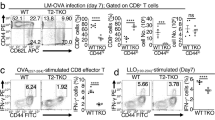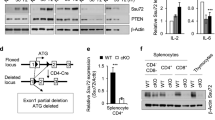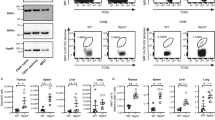Abstract
The Tec kinases Rlk and Itk are critical for full T cell receptor (TCR)-induced activation of phospholipase C-γ and mitogen-activated protein kinase. We show here that the mutation of Rlk and Itk impaired activation of the transcription factors NFAT and AP-1 and production of both T helper type 1 (TH1) and TH2 cytokines. Consistent with these biochemical defects, Itk−/− mice did not generate effective TH2 responses when challenged with Schistosoma mansoni eggs. Paradoxically, the more severely impaired Rlk−/−Itk−/− mice were able to mount a TH2 response and produced TH2 cytokines in response to this challenge. In addition, Rlk−/−Itk−/− cells showed impaired TCR-induced repression of the TH2-inducing transcription factor GATA-3, suggesting a potential mechanism for TH2 development in these hyporesponsive cells. Thus, mutations that affect Tec kinases lead to complex alterations in CD4+ TH cell differentiation.
This is a preview of subscription content, access via your institution
Access options
Subscribe to this journal
Receive 12 print issues and online access
$209.00 per year
only $17.42 per issue
Buy this article
- Purchase on Springer Link
- Instant access to full article PDF
Prices may be subject to local taxes which are calculated during checkout






Similar content being viewed by others
References
Abbas, A., Murphy, K. & Sher, A. Functional diversity of helper T lymphocytes. Nature 383, 787–793 (1996).
Mosmann, T. R., Cherwinski, H., Bond, M. W., Giedlin, M. A. & Coffman, R. L. Two types of murine helper T cell clone. I. Definition according to profiles of lymphokine activities and secreted proteins. J. Immunol. 136, 2348–2357 (1986).
Constant, S. L. & Bottomly, K. Induction of Th1 and Th2 CD4+ T cell responses: the alternative approaches. Annu. Rev. Immunol. 15, 297–322 (1997).
Leitenberg, D. & Bottomly, K. Regulation of naive T cell differentiation by varying the potency of TCR signal transduction. Semin. Immunol. 11, 283–292 (1999).
Bancroft, A. J., Else, K. J. & Grencis, R. K. Low-level infection with Trichuris muris significantly affects the polarization of the CD4 response. Eur. J. Immunol. 24, 3113–3118 (1994).
Bretscher, P. A., Wei, G., Menon, J. N. & Bielefeldt-Ohmann, H. Establishment of stable, cell-mediated immunity that makes "susceptible" mice resistant to Leishmania major. Science 257, 539–542 (1992).
Constant, S., Pfeiffer, C., Woodard, A., Pasqualini, T. & Bottomly, K. Extent of T cell receptor ligation can determine the functional differentiation of naive CD4+ T cells. J. Exp. Med. 182, 1591–1596 (1995).
Pfeiffer, C. et al. Altered peptide ligands can control CD4 T lymphocyte differentiation in vivo. J. Exp. Med. 181, 1569–1574 (1995).
Rao, A., Luo, C. & Hogan, P. G. Transcription factors of the NFAT family: regulation and function. Annu. Rev. Immunol. 15, 707–747 (1997).
Ranger, A. M. et al. Delayed lymphoid repopulation with defects in IL-4-driven responses produced by inactivation of NF-ATc. Immunity 8, 125–134 (1998).
Yoshida, H. et al. The transcription factor NF-ATc1 regulates lymphocyte proliferation and Th2 cytokine production. Immunity 8, 115–124 (1998).
Ranger, A. M., Oukka, M., Rengarajan, J. & Glimcher, L. H. Inhibitory function of two NFAT family members in lymphoid homeostasis and Th2 development. Immunity 9, 627–635 (1998).
Rengarajan, J. et al. Sequential involvement of NFAT and Egr transcription factors in FasL regulation. Immunity 12, 293–300 (2000).
Xanthoudakis, S. et al. An enhanced immune response in mice lacking the transcription factor NFAT1. Science 272, 892–895 (1996).
Peng, S. L., Gerth, A. J., Ranger, A. M. & Glimcher, L. H. NFATc1 and NFATc2 together control both T and B cell activation and differentiation. Immunity 14, 13–20 (2001).
Li, B., Tournier, C., Davis, R. J. & Flavell, R. A. Regulation of IL-4 expression by the transcription factor JunB during T helper cell differentiation. EMBO J. 18, 420–432 (1999).
Zhang, D. H., Cohn, L., Ray, P., Bottomly, K. & Ray, A. Transcription factor GATA-3 is differentially expressed in murine Th1 and Th2 cells and controls Th2-specific expression of the interleukin-5 gene. J. Biol. Chem. 272, 21597–21603 (1997).
Zheng, W. & Flavell, R. A. The transcription factor GATA-3 is necessary and sufficient for Th2 cytokine gene expression in CD4 T cells. Cell 89, 587–596 (1997).
Liao, X. C. & Littman, D. R. Altered T cell receptor signaling and disrupted T cell development in mice lacking Itk. Immunity 3, 757–769 (1995).
Liu, K. Q., Bunnell, S. C., Gurniak, C. B. & Berg, L. J. T cell receptor-initiated calcium release is uncoupled from capacitative calcium entry in Itk-deficient T cells. J. Exp. Med. 187, 1721–1727 (1998).
Schaeffer, E. M. et al. Requirement for Tec kinases Rlk and Itk in T cell receptor signaling and immunity. Science 284, 638–641 (1999).
Fowell, D. J. et al. Impaired NFATc translocation and failure of Th2 development in Itk- deficient CD4+ T cells. Immunity 11, 399–409 (1999).
Dolmetsch, R. E., Lewis, R. S., Goodnow, C. C. & Healy, J. I. Differential activation of transcription factors induced by Ca2+ response amplitude and duration. Nature 386, 855–858 (1997).
Coffman, R. L. & Mosmann, T. R. Isotype regulation by helper T cells and lymphokines. Monogr. Allergy 24, 96–103 (1988).
Stevens, T. L. et al. Regulation of antibody isotype secretion by subsets of antigen-specific helper T cells. Nature 334, 255–258 (1988).
Finkelman, F. D. et al. Lymphokine control of in vivo immunoglobulin isotype selection. Annu. Rev. Immunol. 8, 303–333 (1990).
Wynn, T. A. et al. Analysis of cytokine mRNA expression during primary granuloma formation induced by eggs of Schistosoma mansoni. J. Immunol. 151, 1430–1440 (1993).
Lee, H. J. et al. GATA-3 induces T helper cell type 2 (Th2) cytokine expression and chromatin remodeling in committed Th1 cells. J. Exp. Med. 192, 105–115 (2000).
Ouyang, W. et al. Inhibition of Th1 development mediated by GATA-3 through an IL-4-independent mechanism. Immunity 9, 745–755 (1998).
Hu, Q. et al. Identification of Rlk, a novel protein tyrosine kinase with predominant expression in the T cell lineage. J. Biol. Chem. 270, 1928–1934 (1995).
Kashiwakura, J. et al. Txk, a nonreceptor tyrosine kinase of the Tec family, is expressed in T helper type 1 cells and regulates interferon γ production in human T lymphocytes. J. Exp. Med. 190, 1147–1154 (1999).
Brown, D. R. et al. Limited role of CD28-mediated signals in T helper subset differentiation. J. Exp. Med. 184, 803–810 (1996).
Brown, D. R., Moskowitz, N. H., Killeen, N. & Reiner, S. L. A role for CD4 in peripheral T cell differentiation. J. Exp. Med. 186, 101–107 (1997).
Yamashita, M. et al. T cell receptor-induced calcineurin activation regulates T helper type 2 cell development by modifying the interleukin 4 receptor signaling complex. J. Exp. Med. 191, 1869–1879 (2000).
Blander, J. M., Sant'Angelo, D. B., Bottomly, K. & Janeway, C. A. Jr Alteration at a single amino acid residue in the T cell receptor α chain complementarity determining region 2 changes the differentiation of naive CD4 T cells in response to antigen from T helper cell type 1 (Th1) to Th2. J. Exp. Med. 191, 2065–2074 (2000).
Foucras, G., Gapin, L., Coureau, C., Kanellopoulos, J. M. & Guery, J. C. Interleukin 4-producing CD4 T cells arise from different precursors depending on the conditions of antigen exposure in vivo. J. Exp. Med. 191, 683–694 (2000).
Hosken, N. A., Shibuya, K., Heath, A. W., Murphy, K. M. & O'Garra, A. The effect of antigen dose on CD4+ T helper cell phenotype development in a T cell receptor-α β-transgenic model. J. Exp. Med. 182, 1579–1584 (1995).
Smith, J. A., Tang, Q. & Bluestone, J. A. Partial TCR signals delivered by FcR-nonbinding anti-CD3 monoclonal antibodies differentially regulate individual Th subsets. J. Immunol. 160, 4841–4849 (1998).
Grakoui, A., Donermeyer, D. L., Kanagawa, O., Murphy, K. M. & Allen, P. M. TCR-independent pathways mediate the effects of antigen dose and altered peptide ligands on Th cell polarization. J. Immunol. 162, 1923–1930 (1999).
Reiner, S. L. & Seder, R. A. Dealing from the evolutionary pawnshop: how lymphocytes make decisions. Immunity 11, 1–10 (1999).
Jankovic, D. et al. Single cell analysis reveals that IL-4 receptor/Stat6 signaling is not required for the in vivo or in vitro development of CD4+ lymphocytes with a Th2 cytokine profile. J. Immunol. 164, 3047–3055 (2000).
Ouyang, W. et al. Stat6-independent GATA-3 autoactivation directs IL-4-independent Th2 development and commitment. Immunity 12, 27–37 (2000).
Jankovic, D. et al. Schistosome-infected IL-4 receptor knockout (KO) mice, in contrast to IL-4 KO mice, fail to develop granulomatous pathology while maintaining the same lymphokine expression profile. J. Immunol. 163, 337–342 (1999).
Hu-Li, J., Ohara, J., Watson, C., Tsang, W. & Paul, W. E. Derivation of a T cell line that is highly responsive to IL-4 and IL-2 (CT.4R) and of an IL-2 hyporesponsive mutant of that line (CT.4S). J. Immunol. 142, 800–807 (1989).
Schreiber, E., Matthias, P., Muller, M. M. & Schaffner, W. Rapid detection of octamer binding proteins with 'mini-extracts', prepared from a small number of cells. Nucleic Acids Res. 17, 6419 (1989).
Acknowledgements
We thank M. Erdos, S. John, U. Siebenlist and K. Brown for advice on EMSAs; J. Hu-Li and D. Jankovic for advice on in vitro polarization cultures; J. Cote-Sierra for advice on GATA-3 assays; A. Venegas, M. Chetana, J. Shehadeh and G. Elliott for technical assistance; S. Barbieri, R. Swafford, and C. Eigsti for cell sorting; A. Rao, J. Powell and N. Rice for gifts of antibodies; and R. Germain, D. Jankovic, T. Wynn, M. Kullberg, J. Bluestone, W. Paul and A. Kimmel for critical discussions. Supported in part by the Searle Scholars Program/Chicago Community Trust (P. L. S.) and the HHMI-NIH Scholars Program (E. M. S. and C. M. L.).
Author information
Authors and Affiliations
Corresponding author
Supplementary information
Web Figure 1
GATA-3 protein expression. (a) Purified T cells were stimulated with anti-CD3 for 40 h in the absence of cytokines, nuclear extracts prepared and GATA-3 protein expression examined by immunoblotting with monoclonal anti-GATA-3 or goat polyclonal anti-STAT6. (b) The specificity of the GATA-3 antibody was examined in nuclear extracts from cells that had been differentiated with TH1 or TH2 cytokines for 40 h. (JPG 23 kb)
Rights and permissions
About this article
Cite this article
Schaeffer, E., Yap, G., Lewis, C. et al. Mutation of Tec family kinases alters T helper cell differentiation. Nat Immunol 2, 1183–1188 (2001). https://doi.org/10.1038/ni734
Received:
Accepted:
Published:
Issue Date:
DOI: https://doi.org/10.1038/ni734
This article is cited by
-
Role of the IL-2 inducible tyrosine kinase ITK and its inhibitors in disease pathogenesis
Journal of Molecular Medicine (2020)
-
Genetic Deficiency and Biochemical Inhibition of ITK Affect Human Th17, Treg, and Innate Lymphoid Cells
Journal of Clinical Immunology (2019)
-
RNA-seq of muscle from pigs divergent in feed efficiency and product quality identifies differences in immune response, growth, and macronutrient and connective tissue metabolism
BMC Genomics (2018)
-
IL-2 Inducible Kinase ITK is Critical for HIV-1 Infection of Jurkat T-cells
Scientific Reports (2018)
-
Itk is required for Th9 differentiation via TCR-mediated induction of IL-2 and IRF4
Nature Communications (2016)



